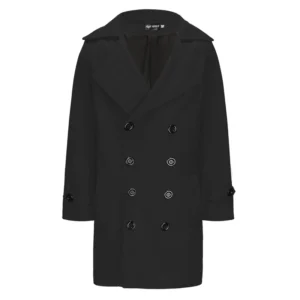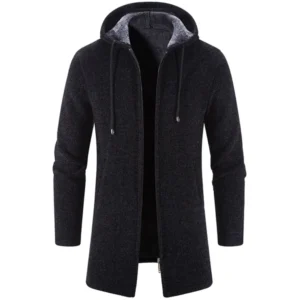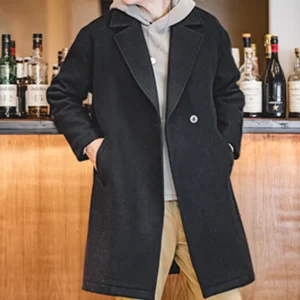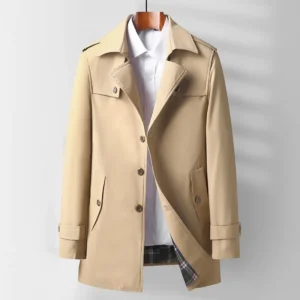Introduction: The Enduring Legacy of Tweed in Men’s Outerwear
Tweed stands as one of the most distinctive and enduring fabrics in men’s outerwear. Characterized by its remarkable durability, distinctive texture, and exceptional warmth, this wool-based textile has clothed generations of men seeking both functionality and style. Born in the rugged landscapes of Scotland and Ireland, tweed was initially developed as a practical solution to harsh weather conditions faced by rural communities.
What began as protective clothing for farmers and countryside dwellers gradually transformed into a symbol of refined taste and timeless elegance. This evolution from purely practical attire to a fashion staple demonstrates tweed’s remarkable versatility and enduring appeal. Today, the fabric continues to feature prominently in men’s coats, maintaining its reputation for quality while adapting to contemporary aesthetics.
Understanding different tweed patterns is essential for anyone interested in choosing the right coat length and style. The pattern you select significantly impacts the coat’s overall appearance, formality, and versatility. In this comprehensive guide, we’ll explore the distinctive characteristics of classic tweed patterns, their historical significance, and how to select the perfect pattern for your personal style. The knowledge of men’s coat length guides combined with an appreciation for tweed patterns will help you make informed choices when adding this timeless garment to your wardrobe.
Whether you’re a tweed enthusiast or considering your first purchase from collections like our men’s tweed coats, this guide will equip you with the expertise to appreciate and select the perfect tweed pattern for your needs.
Understanding Tweed: The Foundations of Texture and Pattern
Before diving into specific patterns, it’s essential to understand how tweed’s distinctive appearance is created. The magic of tweed begins with its fundamental weaving techniques:
- Twill Weave: Most classic tweed utilizes a twill structure, where weft threads pass over and under warp threads in a diagonal pattern, creating the characteristic diagonal lines visible in many tweed fabrics.
- Plain Weave: Some tweeds employ a simpler over-under pattern, resulting in a more uniform appearance with less pronounced texture.
Yarn selection dramatically influences tweed’s texture and visual appeal. Thicker yarns produce a more robust, rugged fabric ideal for country coats, while finer yarns create smoother tweeds suitable for city wear. The distinction between spun yarns (with fibers arranged in varying directions) versus worsted yarns (with parallel fibers) further affects the fabric’s appearance and handle.
Color complexity in tweed emerges from the interplay between different colored yarns in both warp (vertical) and weft (horizontal) directions. This interaction creates the rich, mottled appearance that distinguishes tweed from solid-colored fabrics.
When discussing patterns, clarity in terminology helps appreciation:
* Checks: Patterns formed by crossing horizontal and vertical lines
* Plaids: More complex patterns with multiple crossing lines of different colors and sizes
* Stripes: Linear patterns running in a single direction
The scale of these elements fundamentally affects how a tweed pattern is perceived. Small-scale patterns appear more refined and formal from a distance, while larger patterns make more distinctive statements and can better complement substantial physiques.
The Classic Herringbone Pattern: Timeless Elegance in V-Formation
The herringbone pattern stands as perhaps the most recognized and versatile tweed design, characterized by its distinctive zigzag appearance. This elegant pattern derives its name from its resemblance to a fish skeleton, specifically that of a herring.
What makes herringbone unique is its construction method—created through a broken twill weave where the diagonal pattern reverses direction at regular intervals, forming a series of V-shaped columns throughout the fabric. The result is a sophisticated visual texture that provides interest without overwhelming the garment.
Key characteristics of herringbone include:
- Pattern Variations: Standard herringbone maintains consistent V-formations, while broken herringbone incorporates subtle interruptions in the pattern for added visual interest
- Scale Range: From fine herringbone (appearing almost solid at a distance) to bold statements with clearly visible zigzags
- Color Traditions: Historically dominated by earth tones—browns, grays, and deep greens—though contemporary versions explore everything from vibrant blues to subtle lavenders
Herringbone’s enduring popularity for men’s coats stems from its remarkable versatility. The pattern adds sophistication without ostentation, making it appropriate for both business and casual contexts. The visual texture also effectively breaks up the large surface area of a coat without creating a busy appearance.
For coat styles, herringbone particularly complements structured silhouettes like herringbone pattern coats and Chesterfields, where the pattern’s clean lines echo the garment’s tailored precision. When considering color options, our guide to best colors for herringbone coats provides valuable insights for selecting the perfect shade to complement your wardrobe.
Houndstooth and Its Variations: From Subtle to Statement
Houndstooth offers one of the most distinctive and recognizable patterns in the tweed family. This classic design features a broken check pattern creating pointed shapes that somewhat resemble a dog’s tooth—hence its name. The pattern emerges from a specific four-over-four twill weave structure that creates its characteristic jagged appearance.
What makes houndstooth particularly versatile is its scale variations:
- Puppytooth: A miniaturized version where the pattern appears at roughly half the standard scale, creating a more subtle, refined appearance
- Standard Houndstooth: The classic scale where individual “teeth” are clearly visible at conversational distance
- Oversized Houndstooth: A bold, contemporary interpretation featuring larger pattern elements
The visual impact of houndstooth changes dramatically with viewing distance. From afar, puppytooth can appear as a solid, textured gray, while standard and oversized patterns maintain their distinctive appearance at greater distances.
Traditional houndstooth is most commonly found in black and white or dark brown and cream combinations, creating high contrast that emphasizes the pattern’s distinctive shape. Modern interpretations introduce color variations from subtle navy and gray to more adventurous combinations involving burgundy, forest green, or even mustard.
When considering formality, smaller-scale houndstooth patterns generally read as more formal and conservative, making them excellent choices for professional environments. Larger-scale patterns create more visual impact, suited to statement pieces and casual settings.
Understanding the differences between tweed and modern wool coats can help you appreciate how houndstooth’s distinctive pattern contributes to tweed’s unique character and appearance compared to smoother, more contemporary wool fabrics.
Glen Plaid and Prince of Wales Check: The Aristocratic Patterns
Glen plaid (also known as Glenurquhart check) represents one of the most sophisticated and historically significant tweed patterns. This elegant design features a complex arrangement of small and large checks that create a distinctive geometric appearance. The pattern consists of alternating bands of light and dark checks, often overlaid with a larger check or windowpane pattern.
Prince of Wales check is essentially a variation of Glen plaid distinguished by the addition of an overcheck—a thin, often colorful line that runs through the pattern, creating additional visual interest. This subtle difference elevates the pattern’s complexity and visual richness.
These patterns carry significant heritage in menswear, originating from Scottish estates where they served as regional identifiers. Their aristocratic associations have helped maintain their position as symbols of refined taste and sartorial knowledge.
Traditional color palettes for these patterns include:
- Glen Plaid: Usually features black, white, and gray combinations, creating a subtle, sophisticated appearance
- Prince of Wales: Often incorporates the same base with overchecks in blue, red, or green
The formality of these patterns depends largely on their scale and color contrast. Smaller-scale patterns in subtle colors read as more formal, while larger checks with prominent overchecks create a more casual, sporting impression.
These patterns excel in structured coat styles like single-breasted or double-breasted overcoats. Their geometric precision complements clean lines and tailored silhouettes, making them perfect choices for wool overcoats designed for formal or business wear.
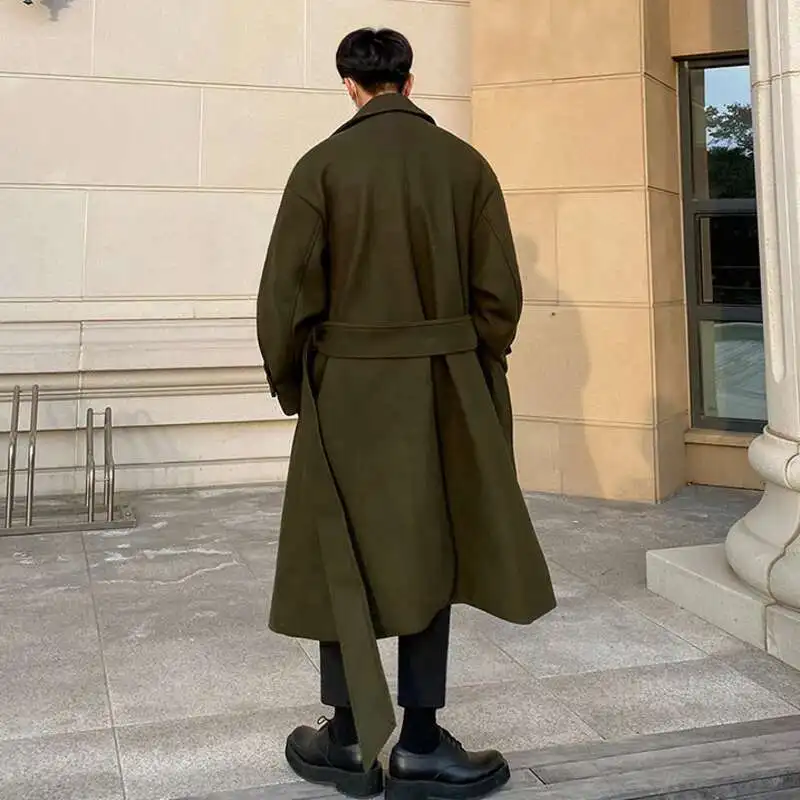
Windowpane Check: Clean Lines and Modern Appeal
The windowpane check represents one of the most straightforward yet visually striking tweed patterns available for men’s coats. As its name suggests, this pattern features a simple grid of thin lines intersecting at right angles, resembling the muntins of traditional windowpanes. This clean geometric structure offers a distinct alternative to more complex check patterns.
The windowpane pattern’s visual impact varies significantly with scale:
- Fine Windowpane: Lines spaced approximately 1-2 inches apart create a subtle, refined appearance
- Medium Windowpane: 2-3 inch spacing produces the classic, easily recognizable pattern
- Bold Windowpane: Wider spacing of 3-4+ inches makes a more dramatic fashion statement
Traditional windowpane checks typically feature dark lines on a lighter background—navy on light gray or brown on tan being common combinations. Contemporary interpretations might reverse this relationship or introduce colorful lines against neutral backgrounds for added visual interest.
The clean, geometric nature of windowpane makes it particularly well-suited to structured, formal coat styles. Single-breasted overcoats and Chesterfields with clean lines complement the pattern’s precision. For a comprehensive selection of styles, our men’s overcoats collection offers various interpretations of this classic pattern.
When styling windowpane tweed coats, consider:
* Pairing with solid-colored garments to let the pattern take center stage
* Keeping accessories simple and understated
* Considering your frame—larger windowpane patterns can be particularly flattering on taller, broader builds
The windowpane’s structured geometry creates a distinctly different visual impression than the complex patterns of Glen plaid or the zigzag movement of herringbone, offering a clean, architectural alternative for the modern man.
Barleycorn and Donegal Tweeds: Texture-Rich Heritage
While many tweed patterns rely on color arrangement and weave structure to create visual interest, barleycorn and Donegal tweeds distinguish themselves through distinctive textural elements that create depth and character.
Barleycorn tweed features a small-scale pattern resembling its namesake grain. The pattern emerges from a specific variation of the twill weave that creates small, raised triangular or diamond-shaped bumps across the fabric’s surface. This three-dimensional quality gives barleycorn tweed a uniquely tactile character that adds subtle visual interest without relying on bold pattern lines or color contrasts.
Donegal tweed, originating from County Donegal in Ireland, is immediately recognizable by its distinctive flecked appearance. Rather than relying on weave structure for pattern, Donegal incorporates small, colorful slubs (knots or irregular thicker sections) of yarn throughout the fabric. These flecks traditionally represent the colors found in the Irish countryside—purples, blues, greens, and yellows—scattered across a neutral base cloth.
Both fabrics typically feature earthy, natural color palettes that reflect their rural origins:
* Barleycorn often appears in browns, tans, and grays that highlight its textural pattern
* Donegal bases typically include browns, grays, blues, or greens, with contrasting flecks providing subtle color accents
These textured tweeds perform exceptionally well in more casual coat styles like raglan-sleeved coats, ulsters, and relaxed overcoats. Their tactile nature makes them particularly suitable for winter wear, where their robust appearance complements seasonal layering.
Understanding whether short or long coats better showcase these textured tweeds is important—longer coats often provide more surface area to appreciate the subtle texture, while shorter coats can create a more concentrated visual impact.
District and Estate Tweeds: The Unique Identity Patterns
Among tweed’s most fascinating expressions are district and estate tweeds—patterns developed to identify individuals with specific geographic regions or landed estates. These distinctive patterns represent some of the most authentic connections to tweed’s historical origins.
District tweeds were traditionally associated with specific regions of Scotland, designed to reflect the colors of the local landscape. Meanwhile, estate tweeds were commissioned by landowners to be worn by staff and guests, serving both as identification and as camouflage during hunting expeditions. The patterns typically feature intricate checks and plaids in colors that harmonize with the surrounding countryside.
What makes these tweeds special is their deep connection to specific places:
- Colors directly inspired by natural elements—heather purples, granite grays, bracken browns
- Pattern complexity evolved to blend with particular landscapes
- Design elements often incorporate symbolic references to estate features or regional characteristics
In contemporary fashion, district and estate tweeds offer a distinctive alternative to more standardized patterns. Their complex designs and rich color combinations provide unique character that sets them apart from mass-produced fabrics.
These tweeds excel in traditional country coat styles like shooting jackets, ulsters with cape details, and full-skirted overcoats. Their robust patterns and hearty textures complement the substantial construction of these garment types.
When incorporating these distinctive patterns into personal style, consider:
* Embracing their heritage with complementary traditional elements
* Allowing the complex pattern to be the focal point of an outfit
* Considering the seasonal appropriateness—these tweeds often work best in autumn and winter contexts
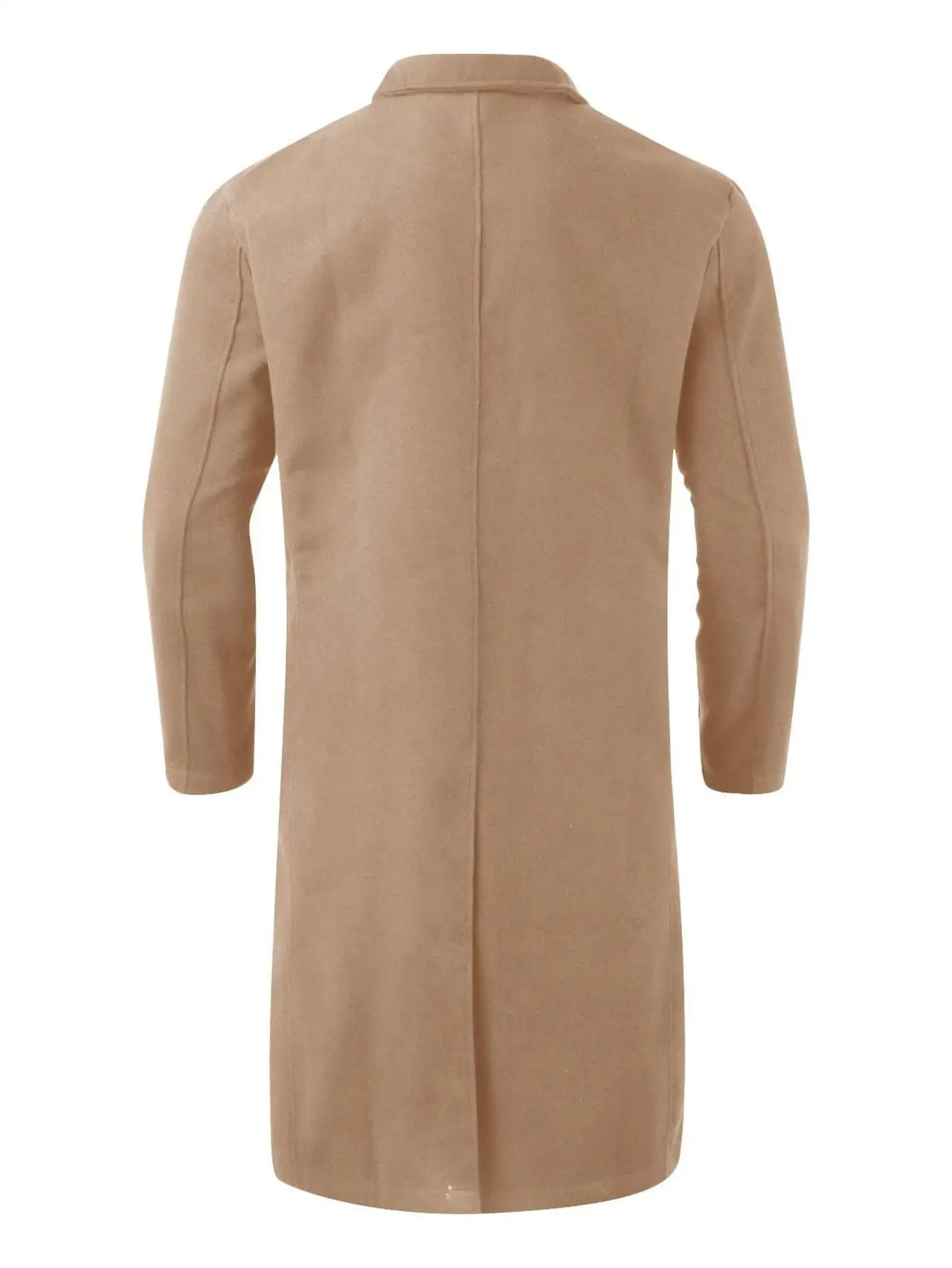
Selecting the Perfect Tweed Pattern: A Comprehensive Guide
Choosing the ideal tweed pattern for your coat requires consideration of several key factors that balance personal style, practical needs, and the coat’s intended purpose.
Start by evaluating your personal style and how the coat will integrate with your existing wardrobe:
- Conservative dressers may prefer subtle herringbone or fine puppytooth patterns
- Style enthusiasts might explore distinctive windowpane or Glen plaid designs
- Those embracing heritage style could consider barleycorn or district tweeds
Consider the occasions where you’ll wear your tweed coat:
* Business and formal settings generally call for refined patterns like fine herringbone, puppytooth, or subtle Glen plaid
* Casual and weekend wear accommodates bolder patterns like windowpane, Prince of Wales, or Donegal tweed
* Country and outdoor activities pair naturally with textured options like barleycorn or estate tweeds
Pattern scale should harmonize with your physical proportions:
* Larger frames can confidently carry bigger patterns like bold windowpane or large-scale herringbone
* Smaller builds often look best in finer patterns like puppytooth or small-scale Glen plaid
* Average builds can explore medium-scale patterns adjusted to personal preference
The formality spectrum of tweed patterns ranges from most subtle to most distinctive:
1. Fine herringbone and puppytooth (most formal)
2. Standard herringbone and Glen plaid
3. Prince of Wales and medium-scale windowpane
4. Barleycorn and houndstooth
5. Bold windowpane and Donegal (most casual)
Seasonal considerations also matter—darker, more subdued patterns typically work better in winter, while lighter options with visible texture can transition effectively into spring and fall.
For those looking to build a tweed coat collection, consider starting with a versatile herringbone before exploring more distinctive options like windowpane or Prince of Wales. Our guide to classic men’s overcoats for formal wear provides additional context for selecting patterns appropriate for dressier occasions.
Mens Double Breasted Pea Coat, Mens Wool Blend Coat, Mens Wool Pea Coat
Price range: $136.84 through $157.36 Select options This product has multiple variants. The options may be chosen on the product pageMens Cashmere Overcoat, Mens Hooded Winter Coat, Mens Wool Blend Coat
Price range: $128.72 through $139.68 Select options This product has multiple variants. The options may be chosen on the product pageMens Black Overcoat, Mens Black Wool Coat, Mens Wool Overcoat
$339.18 Select options This product has multiple variants. The options may be chosen on the product pageMens Grey Overcoat, Mens Wool Blend Coat, Mens Wool Overcoat
$201.28 Select options This product has multiple variants. The options may be chosen on the product pageMens Herringbone Coat, Mens Long Overcoat, Mens Wool Overcoat
Price range: $197.16 through $203.69 Select options This product has multiple variants. The options may be chosen on the product pageMens Long Overcoat, Mens Topcoats
Price range: $189.40 through $196.88 Select options This product has multiple variants. The options may be chosen on the product page
Quality and Craftsmanship: Identifying Superior Tweed Fabrics
The visual appeal of a tweed pattern is only part of what makes a quality coat. Understanding how to identify superior tweed fabrics ensures your investment delivers both aesthetic pleasure and long-term satisfaction.
Key indicators of high-quality tweed include:
- Fiber Composition: Premium tweeds contain high percentages of virgin wool with minimal synthetic content. The best examples may incorporate cashmere or mohair for enhanced softness or luster.
- Weave Density: Quality tweed features a tight, consistent weave with enough density to provide structure while maintaining appropriate drape.
- Yarn Quality: Look for fabrics with consistent yarn thickness and minimal slubs (unless intentionally part of the design, as in Donegal tweed).
- Color Clarity: Superior tweeds display clear color definition between pattern elements with precise pattern alignment throughout the garment.
Heritage mills from Scotland, Ireland, and England represent the gold standard in tweed production. These established producers maintain traditional weaving techniques while incorporating modern quality control measures to ensure consistent excellence.
When examining tweed in person, use both visual and tactile assessment:
* Run your hand across the fabric—quality tweed feels firm yet supple
* Hold the fabric to light to check for weave consistency
* Examine pattern alignment at seams and pockets
* Test resilience by gently crushing a portion in your hand—good tweed springs back readily
For coats specifically, appropriate weight is crucial—typically 16-20 ounces per yard provides ideal structure and warmth without excessive bulkiness. Heavier weights excel in durability and wind resistance, while lighter tweeds offer greater versatility across seasons.
The quality of the tweed fabric directly affects how well pattern definition maintains over time. Superior fabrics hold their shape and pattern clarity through years of wear, making them worthy investments for your wardrobe.
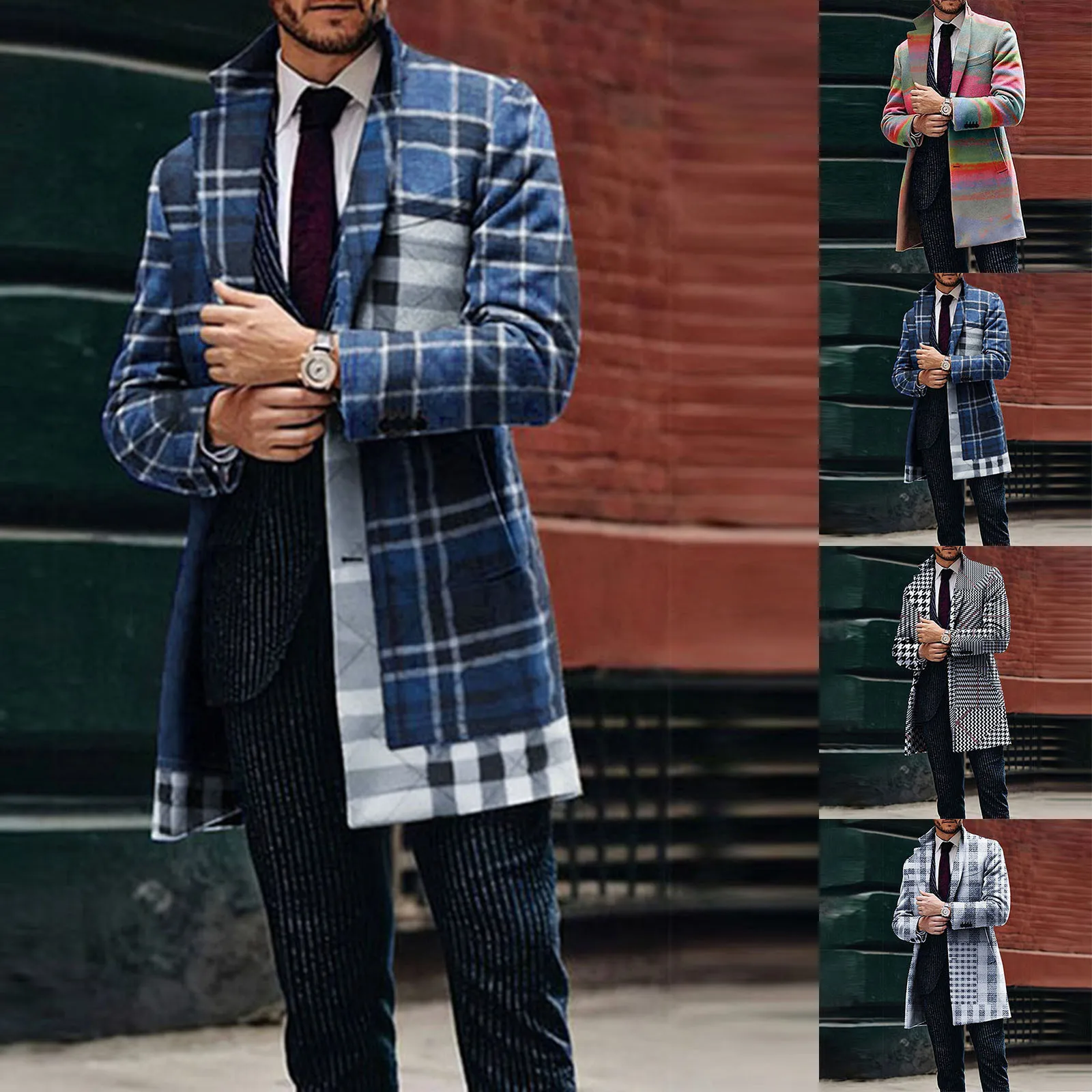
Our wool coats collection showcases various tweed patterns crafted from quality materials selected for both their aesthetic appeal and long-term durability.
Supplementary Content: Is Tweed Still a Relevant Choice for Modern Men?
In an age of synthetic fabrics and fast fashion, tweed remains remarkably relevant for the discerning modern man. This enduring fabric has successfully navigated the transition from traditional countryside attire to contemporary urban fashion through thoughtful adaptation and inherent qualities that align with current values.
Today’s designers have reimagined traditional patterns in ways that respect heritage while embracing modern sensibilities—slimmer cuts, lighter weights, and unexpected color combinations bring fresh perspective to classic designs. Herringbone appears in tailored city coats, while windowpane checks find new life in relaxed weekend wear.
Tweed’s sustainable attributes resonate particularly well with contemporary concerns. As a natural fiber that can last decades when properly cared for, it represents a counterpoint to disposable fashion. Its durability and timeless appeal make it an environmentally responsible choice aligned with growing interest in sustainable wardrobe investments.
Modern styling approaches have further extended tweed’s relevance. Pairing traditional patterns with contemporary casual elements—like combining a herringbone coat with premium denim and sneakers—creates versatile looks that bridge formal and casual contexts. Our dress coat collection demonstrates how classic tweed patterns can be incorporated into modern formal wear with sophisticated results.
Supplementary Content: How Does Tweed Compare to Other Coat Fabrics?
When evaluating coat fabrics, tweed offers a distinctive profile compared to other common options:
Warmth Properties: Tweed provides excellent insulation comparable to standard wool overcoating, though less warm than specialized cashmere or camel hair. Its natural air pockets trap heat efficiently while allowing breathability.
Weather Resistance: Traditional tweed excels in damp conditions due to its tight weave and natural lanolin content, offering better water resistance than cashmere or untreated wool. However, modern technical fabrics surpass it for extreme weather protection.
Durability: Few natural fabrics match tweed’s legendary durability. Its robust structure withstands abrasion and heavy use better than smoother options like cashmere or camel hair, making it ideal for daily wear.
Maintenance Requirements: Tweed typically requires less frequent cleaning than smoother wools due to its textured surface that hides minor soiling. However, it benefits from professional cleaning and careful storage to maintain its structure.
Aesthetic Properties: While cashmere offers unmatched softness and drape, and melton wool provides clean, sharp lines, tweed’s unique advantage lies in its visual depth and character created through complex patterns and textural interest.
Tweed’s versatility also sets it apart—few other fabrics transition as effectively between country walks and city meetings, or between casual weekends and formal events when selected in appropriate patterns. For more guidance on selecting appropriate coat lengths for winter conditions, our winter coat length guide provides valuable insights for tweed coat selection.
Supplementary Content: What Are the Essential Care Tips for Tweed Coats?
Proper care extends the life of tweed garments, preserving both pattern clarity and structural integrity:
Storage Techniques
* Hang on broad, sturdy wooden hangers that support the shoulders
* Allow adequate space between garments to prevent crushing
* Use breathable garment bags rather than plastic during off-season storage
* Place cedar blocks nearby to deter moths without direct contact with the fabricCleaning Methods
* Brush after each wearing with a soft clothes brush in the direction of the nap
* Spot clean minor stains promptly using minimal moisture
* Dry clean only when necessary (typically once per season) using cleaners experienced with wool
* Air thoroughly after wear or exposure to moisture before storingMoth Prevention
* Ensure coats are clean before storage—food particles and body oils attract pests
* Use cedar or lavender deterrents rather than mothballs
* Inspect stored garments periodically for signs of moth activity
* Maintain proper humidity levels to prevent mustiness (30-50% ideal)Addressing Common Issues
* For minor pilling, use a specialized fabric shaver with extreme caution
* Repair small tears or loose threads immediately before they expand
* Reinforce buttons before they loosen
* Block and reshape damp areas by patting gently, never rubbingProfessional Maintenance
* Schedule comprehensive inspection and cleaning at season’s end
* Consider waterproofing treatments every few years for coats used in damp conditions
* Have repairs made by tailors experienced with tweed’s unique properties
With proper care, a quality tweed coat can remain a wardrobe cornerstone for decades, developing character and patina that enhances rather than diminishes its appeal.


